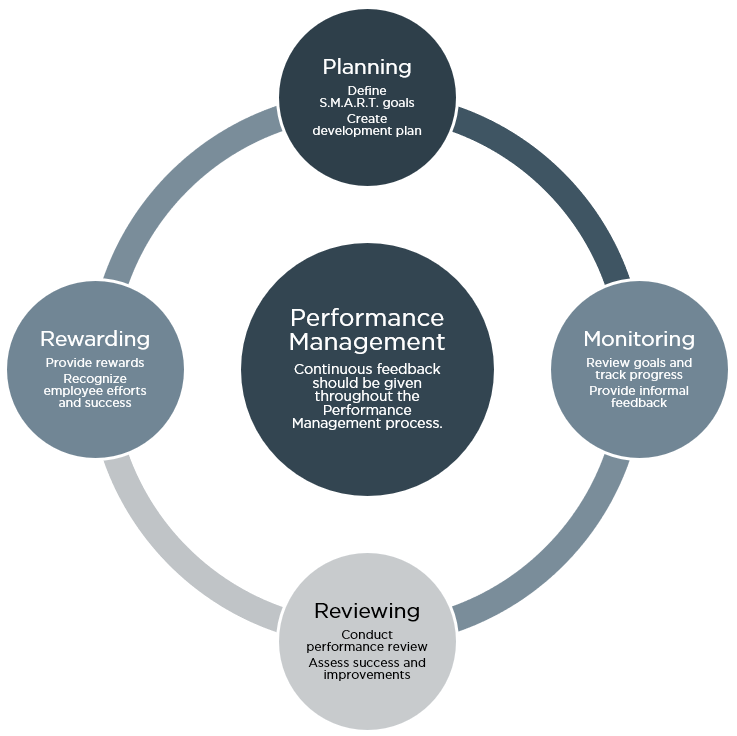By Ainsley LaCroix – HR Consultant, HR @ Your Service
Recently, we talked about the power of feedback, its role in making teams stronger and strategies for how to make it a regular – and welcomed – part of interactions between leaders and employees. As essential as a less-structured approach to feedback can be to an organization’s success, having a solid and well-planned approach to managing performance is just as essential. A thorough performance management process aligns the goals and objectives of employees with those of the company, promotes continuous learning and development, and drives the ongoing improvement of individuals and teams.
What is performance management?
Performance management is a systematic approach to improving the effectiveness of individuals and organizations by evaluating the performance of employees and providing feedback, guidance, and support to help them reach their full potential.
Advantages of a performance management process
It’s not a secret that as a leader or business owner we want employees to perform well and, ideally, get a sense of satisfaction from succeeding in their role.
So, how does a structured performance management strategy help with this?
- Improving employee performance. When employees are provided with regular insight into their performance, they are able to identify both their strengths and areas for improvement. This helps employees to further develop the skills and knowledge they need to reach their full potential in your organization.
- Aligning employee performance with company goals. By setting clear expectations and goals that are aligned with the objectives of the company, and regularly monitoring and reviewing performance, leaders ensure that employees are contributing to the overall success of the organization.
- Supporting employee development. Providing employees with regular feedback and coaching supports their professional development. This coaching guides learning and development opportunities and helps employees grow and progress in their career with the organization, contributing to talent management efforts.
- Increasing organizational efficiency. Performance management serves as a tool to measure results and employee productivity. When employees work towards the most important company goals and objectives, resources are used effectively, organizational efficiency increases and overall business results improve.
- Enhancing employee motivation. Regular recognition for achievements and celebrating successes helps with employee motivation and achieving a sense of satisfaction in their role. When employees feel good about their work, it reinforces their commitment to their team, their leader, and to contributing to the success of the organization.
- Facilitating open communication. Open communication helps to build trust and improve the overall relationship between leaders and employees. A performance management process provides opportunities for leaders and employees to have honest and ongoing conversations about performance, and to discuss any challenges or obstacles they may be facing.
Knowing the process stages
Knowing the stages of performance management allows leaders to effectively implement a process with their teams. An effective performance management strategy defines performance expectations, creates opportunities for regular coaching, sets the stage for performance evaluation, and serves as a tool for issuing recognition and rewards.

Stage 1 – Planning
In this stage, leaders and employees work together to identify S.M.A.R.T (Specific, Measurable, Achievable, Relevant, and Timely) goals that align with the expectations and overall team or business goals for the year ahead. Planning also includes discussing resources, support, and training that will be provided to help the employee achieve their individual goals.
From this stage, a development plan is created for the employee, to be reviewed at regular touchpoints throughout the year.
Stage 2 – Monitoring
This stage is focused on regularly checking in with employees to provide feedback on their performance and to help them stay on track toward achieving their goals.
Monitoring is an opportunity for leaders to provide guidance and support to employees, and to help them overcome obstacles they may be facing. Leaders can use this stage to address any performance issues and to provide coaching and mentoring to help employees improve and develop further.
Regular weekly or monthly check-ins provide opportunities for ongoing feedback and should serve as a foundation for a more formal performance evaluation.
Stage 3 – Reviewing
During this stage, leaders meet individually with employees and provide an overall evaluation of their performance, including feedback on both their strengths and areas for improvement. Employees are also given the opportunity to reflect on the progress made toward achieving their goals and to bring forth any of their observations about their performance over the past year.
The outcome of the reviewing stage is a formal performance evaluation, which should be documented and used to inform future performance management processes. This evaluation provides a clear understanding of an employee’s performance and should be used to guide future discussions and development plans.
Stage 4 – Rewarding
The final stage of performance management is an important part of the process, as it is key to motivating employees by recognizing their achievements. Recognition and rewards can be in the form of verbal praise, bonuses, promotions, or other incentives, and should be tied to specific performance goals.
Retain employees with a performance management strategy
Defining and implementing a performance management process in your organization helps to create a culture of continuous improvement and drives performance outcomes, as employees are motivated to achieve their goals and are then recognized for their efforts.
Employees who are given goals and a plan for achieving them – especially if it is a plan they helped create – are well poised to thrive in their roles, contribute to company success, and are far more likely to stay with an organization. And retaining employees, in our ever-evolving economy and job market, should be a goal every organization wishes to achieve.
Explore these other posts by People First HR
